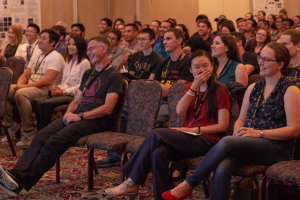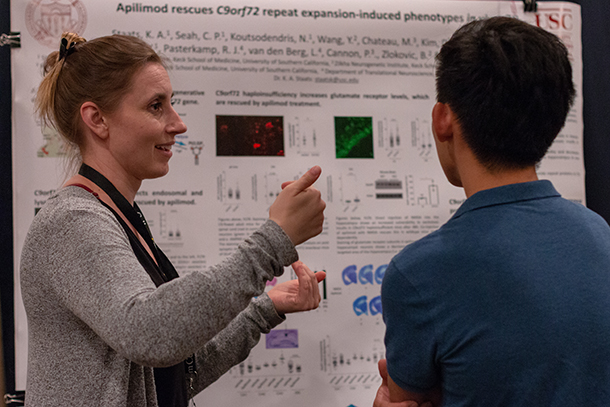Students and trainees took center stage at the annual retreat for the Keck School of Medicine of USC’s Department of Stem Cell Biology and Regenerative Medicine. They presented their latest research to the 180 stem cell scientists who gathered at the event, held at the Pala Mesa Resort in Fallbrook, California, this September.
“This is one of my favorite events, because we faculty do nothing,” said Department Chair Andy McMahon, PhD. “We don’t have to speak, and the people in our lab speak. This is an opportunity to listen, to think, to discuss, to engage a familiar face that you’ve never engaged before that you’ve seen around the building.”
Several students and trainees presented their research about development, disease, injury, repair and regeneration in talks, as well as dozens of scientific posters.
Daniel Eun Koo from the laboratory of Scott Fraser discussed the development of the heart — which is the organ most commonly affected by birth defects. Koo discussed how the heart develops in response to not only genetic signals, but also mechanical forces. These forces are critical for cueing the heart to transform from a symmetrical cone into an asymmetrical tube during the early stages of zebrafish embryonic development.
Another cardiovascular researcher, Susana Cavallero from the laboratory of Henry Sucov, shared her work about the development and regeneration of mouse blood vessels. She focused on two genes, known as CXCL12 and CXCR4 receptor, that drive the generation of arteries in the heart as well as in the kidneys.
Adnan Chowdhury from the laboratory of Rong Lu talked about regenerating the blood and immune system following bone marrow transplants to treat cancer and other diseases. He focused on a special type of blood stem cell that secretes a protein called IL-10. While these IL-10 blood stem cells are very good at producing immune cells called B cells, they are less efficient at reconstituting the blood and immune system in general. Therefore, it might be best to exclude IL-10 blood stem cells from the bone marrow used for transplantations.

Andy McMahon, left, laughs during the Department of Stem Cell Biology and Regenerative Medicine annual retreat. (Photo/Sergio Bianco)
Sophia Petraki from the laboratory of Amy Ryan (Firth) described the development of the part of the lung called the alveoli, which facilitate the exchange of oxygen and carbon dioxide. She focused on the role of a gene called IGFBP2, which regulates the differentiation of key cell types in the alveoli.
Nils Lindstrom from the McMahon Lab explained how precursor cells give rise to the diversity of mature cell types in the nephron, which is the filtering unit of the adult human kidney. Lindstrom discussed the genetics as well as the complex cellular dynamics involved in the development of this elaborate vital organ.
Another kidney researcher, Zipeng Zeng from the laboratory of Zhongwei Li, shared his findings about polycystic kidney disease (PKD), in which the kidney grows large, lumpy and dysfunctional. To study this disease, Zeng and his colleagues are optimizing their techniques for growing human mini kidneys, called kidney organoids, in the laboratory. By studying kidney organoids that have the genetic mutation known to cause PKD in humans, they are trying to understand and find treatments for this life-threatening disease.
Gabe Ferguson from the laboratory of Denis Evseenko talked about how gene activity drives the development of joint cartilage, which is lost in arthritis. Ferguson shared several key findings, including the fact that stem cell-derived cartilage cells do not fully develop in the Petri dish, but retain the genetic hallmarks of fetal cartilage. To fully mature, the stem cell-derived cartilage must be transplanted into a living organism.
Joanna Smeeton from the laboratory of Gage Crump continued the discussion of arthritis. She revealed that zebrafish can develop arthritis in their jaws, and can also quickly regenerate their cartilage, as well as their ligaments, and fully recover. Smeeton is exploring the specific gene activity that enables this recovery in fish, in hopes of finding clues about how to stimulate similar regeneration in humans.
Jason Hsieh from the laboratory of Francesca Mariani shared research about the sheath of tissue that surrounds bones, called the periosteum. This tissue has the ability to regenerate bone, which could be useful for treating fractures that fail to heal.
Rajiv Tiwari from the laboratory of Joseph T. Rodgers talked about how removing a part of the liver impairs the healing of muscle injuries elsewhere in the body. Liver injury appears to trigger muscle stem cells to enter a dormant state, dubbed “G-Resist.”
Eric Hendricks from the laboratory of Justin Ichida described deficits in neural stem cells (NSCs) derived from patients with a form of ALS caused by a mutation in the gene C9ORF72. These patient-derived NSCs proliferate less than normal, and tend to prematurely differentiate into neurons. Possibly as a result, patients with this mutation have less gray and white matter in their brains, even before they develop any symptoms of disease.
Katie Galloway from the Ichida Lab and Vincent Yu from the Neil Segil Lab presented their joint project, funded by a Doerr Challenge Grant to promote collaborative research between graduate students and postdocs from different labs. Together, they developed a new approach for building what’s known as an enhancer map, which describes which genes are activated or deactivated in cells. They used their map to compare natural muscle nerve cells with those developed from stem cells.
Jeffrey Santoso from the laboratory of Megan McCain introduced research about engineering mature, functional skeletal muscle, which can be used for testing drugs to treat diseases such as ALS. The researchers grow these muscle fibers on water-logged gel made from gelatin. They’re also developing lab-grown models of the connections between muscles and nerves.
Ksenia Gnedeva from the Segil Lab revealed new findings about the development of the sensory cells in the inner ear, which are critical for balance and hearing. Progenitor cells require signals from a specific family of genes, called SoxC transcription factors, in order to become sensory cells.
Albina Ibrayeva from the laboratory of Michael Bonaguidi talked about how aging leads to a decline in the generation of new brain cells, causing cognitive decline and neurological disease. She discussed specific gene networks that cause neural stem cells to go dormant, shutting down the pipeline of new neurons.
Junjun Jing from the laboratory of Yang Chai talked about mouse incisors, which never stop growing. He talked about the interactions between two types of cells involved in this growth: stem cells, and the so-called “transit amplifying cells” that proliferate and then differentiate into more specialized cells.
Calvin Lam from the laboratory of Leonardo Morsut introduced a computer program called CompuCell3D, which can predict the dynamics of developmental processes, such as cells adhering to each other to form layers, spheres and other basic structures. This computer program can help guide efforts to build lab-grown tissues, which can be used to study disease or even grow replacement organs.
Nick Llewellyn from the laboratory of Paula Cannon discussed how an HIV infection can become latent and persist despite the currently available therapies. Llewellyn and his colleagues are studying ways to identify and potentially treat these latently-infected cells.
Three researchers also addressed what happens when stem cells go rogue and cause cancer.
Diane Kang from the laboratory of Min Yu described the role of a gene, called truncated keratin 81, in the metastatic spread of breast cancer. For these patients, this gene can promote metastasis to the lung and possibly more aggressive overall cancer growth.
Byoung san Moon from the laboratory of Wange Lu talked about how a gene called Mbd3 contributes to both recurrence and chemotherapy resistance in a deadly form of brain cancer called glioblastoma.
Shi (Steve) Yu from the laboratory of Qi-Long Ying presented his research on cancer immunotherapy using a type of immune cell called a macrophage. He is genetically modifying these cells so that they can specifically target solid tumors.
In the keynote address, Dennis Clegg from the University of California, Santa Barbara, described the research behind an ongoing clinical trial to treat the most common form of age-related macular degeneration (AMD), a leading cause of blindness. In AMD, cells that support the retina die. Clegg is part of a large project funded by CIRM and is collaborating with scientists from USC, Caltech, City of Hope and University College London to deliver replacement retinal support cells, derived from stem cells, to patients.
“I’d like to thank all of you for attending,” said postdoc Joanna Smeeton, who organized the retreat with PhD students Riana Parvez and Tracy Tran. “I hope you got to see the breadth and depth of the research going on in our department.”
— Cristy Lytal


